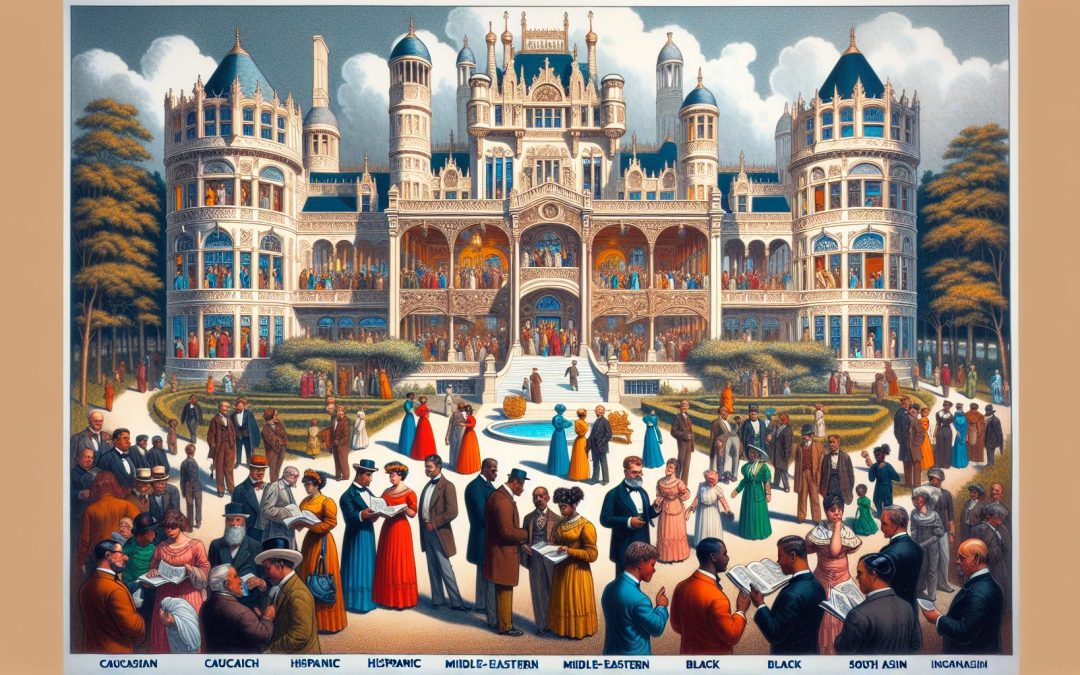Nestled atop a picturesque hill, Wrigley Mansion has always caught my eye. It’s not just a grand estate but a slice of history, transformed from a private residence into a museum that whispers tales of the past. Built in 1932, it’s been a beacon of luxury and architectural beauty, standing as a testament to the lavish lifestyles of its era.
Walking through its opulent halls, I’ve often felt transported back in time. The mansion, once the winter retreat for the chewing gum magnate William Wrigley Jr., now serves as a fascinating museum, offering a glimpse into a bygone era of splendor. It’s a place where history and luxury intertwine, inviting visitors to explore its rich heritage and stunning views.
History of Wrigley Mansion
When I first set eyes on Wrigley Mansion, I was struck by its unmistakable beauty and grandeur. It’s not just a building; it’s a piece of history, meticulously preserved in the heart of Phoenix, Arizona. Built in 1932, this magnificent estate was the winter retreat for William Wrigley Jr., the chewing gum tycoon whose name is recognized around the world.
Wrigley Mansion stands as a testament to the era’s opulence and Wrigley’s personal success. Constructed as a 50th-anniversary gift to his beloved wife, Ada, the mansion was designed with love and immense care, making it more than just a home. It was a symbol of their enduring love and Wrigley’s accomplishment in the business world.
The architectural detail is something that always catches my eye. The mansion blends Spanish Colonial Revival with California Monterey and Mediterranean influences. This unique mixture resulted in a stunning 24-room palace that boasts incredible panoramic views of the mountains and the city below. Its prime location atop a hill perfectly complements the architectural genius, providing visitors with a breathtaking vista.
Throughout the years, Wrigley Mansion has had its share of facelifts and renovations, yet it has always maintained its historic charm and elegance. After changing hands several times post-Wrigley’s era, it has now been transformed into a dynamic museum that also serves as a popular venue for events.
What really makes the mansion stand out, apart from its history and beauty, is its capacity to take you back in time. Walking through its opulent halls, I could almost feel the presence of the Wrigleys, hosting lavish parties for their high-society friends. It’s as if the walls themselves echo with tales of the past, inviting visitors to lose themselves in the grandeur of a bygone era.
Visiting Wrigley Mansion isn’t just about seeing an old house; it’s about experiencing the legacy of an iconic figure in American history and the enduring beauty of architectural artistry.
Architectural Beauty

When I first lay eyes on Wrigley Mansion, its architectural beauty immediately captivates me. It’s not just the size or the grandeur but the intricate details and the blend of styles that make it truly unique. The mansion is an exquisite example of how Spanish Colonial Revival, California Monterey, and Mediterranean styles can be harmoniously merged to create a structure that’s both imposing and welcoming.
As I wander through the mansion, I’m struck by the attention to detail in every room. The hand-painted ceilings and the imported tiles tell a story of luxury and an eye for beauty that William and Ada Wrigley cherished. Each of the 24 rooms has its own character, yet they all reflect the elegance and sophistication of the era in which the mansion was built.
The exterior is just as magnificent, with its sprawling terraces and well-manicured gardens offering panoramic views that are nothing short of breathtaking. Whether it’s the lush landscapes or the city lights that sparkle in the distance, the mansion’s surroundings add to its majestic appearance. It’s easy to see why the Wrigleys chose this spot for their winter retreat. The blend of architecture and nature creates a serene yet opulent setting, perfect for both relaxation and celebration.
Exploring Wrigley Mansion’s architectural beauty, I can’t help but feel transported back in time. It’s not just a step into the past but an opportunity to experience the lavish lifestyle of one of America’s most prominent families. The architectural details not only showcase the Wrigleys’ wealth and status but also their love for art, culture, and beauty. It’s these elements that make Wrigley Mansion a true masterpiece, standing the test of time as both a historic landmark and a testament to architectural elegance.
William Wrigley Jr.: The Man Behind the Mansion
In diving deeper into the history of the Wrigley Mansion, I can’t help but feel intrigued by the life of its original owner, William Wrigley Jr. His story is not just a tale of wealth and success but a testament to the power of perseverance and vision.
Born in 1861, William started his career selling soap for his father’s company. What sets his story apart is his innovative marketing strategy; he offered free baking powder with each soap purchase. This tactic proved so successful that he pivoted to selling baking powder full-time, with chewing gum as the promotional item. It wasn’t long before the chewing gum became more popular than the baking powder itself, leading William to establish the Wrigley Company in the late 19th century.
The success of the Wrigley Company made William one of the wealthiest men in America. Yet, it’s not just his business acumen that stands out; it’s also his commitment to his community and employees. He was known for his philanthropy and for creating a positive work environment, which was quite revolutionary at the time.
As his wealth grew, so did his love for exquisite architecture and places of great beauty. It was this passion that led him to build the Wrigley Mansion in Phoenix, Arizona, as a 50th-anniversary gift for his wife, Ada. The mansion wasn’t just a home; it was a reflection of their shared love for art, culture, and beauty, something that I find incredibly moving.
From selling soap to becoming a chewing gum mogul, William Wrigley Jr.’s journey is a fascinating chapter in the story of the Wrigley Mansion. His legacy, embodied in the walls and gardens of this beautiful estate, continues to inspire and captivate those who walk its halls. The mansion is more than just a building; it’s a monument to a man who believed in the value of hard work, innovation, and the importance of leaving a lasting impact on the world.
Transformation into a Museum
After decades of serving as the Wrigley family’s opulent winter retreat and subsequently cycling through various owners, the magnificent Wrigley Mansion entered a new chapter. I’ve always been fascinated by how historic homes evolve over time, and the transformation of this particular mansion into a museum is a story that captures the imagination.
In the late 20th century, the mansion was purchased by a business magnate who saw its potential not just as a private residence but as a cultural landmark that could benefit the public. The decision to convert it into a museum was driven by a desire to preserve its architecture and history for future generations. The transition wasn’t immediate, but gradual, involving extensive renovations and restorations to bring the mansion back to its former glory.
The mansion’s interior is now a testament to the lavish lifestyle of the early 20th century, with each room meticulously restored to reflect its original condition. Visitors are transported back in time as they wander through grand halls and intimate spaces, each telling a story of the family’s life and times.
As a museum, it now holds guided tours that shed light on the rich history of the Wrigley family, their business empire, and their contributions to American society. Through these tours, artifacts, and exhibitions, the mansion educates and inspires, drawing in thousands of visitors each year.
The process of transforming the Wrigley Mansion into a museum also included opening it up for events. It’s become a sought-after venue for weddings, galas, and various social gatherings, blending historical charm with modern elegance. In doing so, the mansion continues to be a lively part of the community, echoing William Wrigley Jr.’s vision of creating spaces that bring joy and beauty into people’s lives.
So when I reflect on the transition of the Wrigley Mansion from a private residence to a museum, it’s clear that its walls are not just made of brick and mortar but of stories and memories that continue to enchant and educate.
Exploring Wrigley Mansion Today

When I first stepped into the Wrigley Mansion today, I couldn’t help but be transported back in time. The mansion, now a bustling museum, has preserved the opulence and grandeur that characterized it as a pinnacle of early 20th-century luxury. Each room tells a story, rich with historical artifacts and personal items that belonged to the Wrigley family. It’s like walking through a time capsule, where each corner reveals another secret from the past.
Guided tours are a must when you visit. They’re not just tours; they’re storytelling sessions that bring the mansion’s history to life. I learned about the architectural beauty and the strategic thinking behind some of the mansion’s most iconic features. From the hand-carved staircases to the stunningly preserved ballroom, every detail has a story.
One of the highlights for me was the Exhibition Hall. It houses a variety of exhibitions that dive deep into the Wrigley family’s impact on American society and culture. Changing periodically, these exhibitions ensure that no two visits to the mansion are ever the same. It feels like there’s always something new to discover, making each visit uniquely enlightening.
Aside from the historical significance, the mansion also serves as a vibrant community hub. It hosts events, weddings, and social gatherings, proving that it’s more than just a museum; it’s a place where the past and present merge. The sprawling gardens, which are meticulously maintained, offer a serene escape from the bustle of modern life. They remind me that William Wrigley Jr.’s vision of creating joy and beauty in people’s lives is still very much alive.
Every time I leave the Wrigley Mansion, I find myself eagerly looking forward to my next visit. There’s just so much to absorb, and I feel like I’ve only scratched the surface.
Conclusion
Exploring the Wrigley Mansion has been nothing short of a journey back in time, wrapped in the elegance of the past. It’s clear that this historic landmark isn’t just a relic; it’s a living, breathing space that continues to educate and enchant. Whether it’s the architectural beauty, the rich history, or the serene gardens, there’s something here for everyone. I’m already looking forward to my next visit, eager to see what new exhibitions await. If you’ve never experienced the charm of the Wrigley Mansion, I’d say it’s high time you did. Trust me, it’s an adventure you won’t forget.







